Introduction
The production of new superheavy nuclei (SHN) is a challenging frontier in low-energy nuclear reactions. Over the years, experimental and theoretical nuclear physicists have explored SHN synthesis since the prediction of the “island of stability” around Z = 114, N = 184 [1, 2]. The Skyrme–Hartree–Fock method considers Z = 120, 124, or 126 and N = 172 or 184 as magic numbers [3]. The synthesis of superheavy elements (SHEs) Z = 107–112 was accomplished in GSI using cold fusion reactions with Pb and Bi targets [4]. However, despite the successful synthesis of SHE Z = 113 via the cold fusion reaction 70Zn + 209Bi at RIKEN [5], the evaporation residue cross section (ERCS)
In recent years, several new isotopes with Z≤118 have been synthesized using modern accelerators, such as the DC-280 and U-400 of the Dubna SHE factory, RILAC of RIKEN, SFC of HIRFL, and UNILAC of GSI [7, 12-16]; however, the production of SHEs with Z>118 remains a challenge. Previous attempts to produce SHEs with Z=120 using 58Fe+244Pu [6] and 54Cr + 248Cm [17] reactions at Dubna and GSI, respectively, did not observe any α decay chains associated with this element. The three events reported by the GSI in Ref. [17] were later determined to be random events [18]. In 2020, with the gas-filled recoil separator TASCA at GSI, the search for synthesizing SHEs with Z=119 and Z=120 was conducted via the reactions 50Ti + 249Bk and 50Ti + 249Cf, yet neither was detected [19]. In 2022, RIKEN estimated the optimal incident energy for synthesizing SHE Z=119 through the reaction 51V+248Cm [20]. Therefore, the synthesis of SHEs Z>118 requires not only more advanced detection and identification techniques but also an appropriate reaction system.
Several models and different fusion mechanisms have been proposed to accurately describe the process of fusion-evaporation reactions. The improved quantum molecular dynamics (ImQMD) model [21], time-dependent Hartree-Fock theory [22-25], fusion-by-diffusion model [26], cluster dynamical decay model [27], two-step model [28, 29], dinuclear system (DNS) model [30-44], and other methods [45-48] have proved to be reliable in reproducing experimental data and have provided predictions about the synthesis of unknown nuclei [22, 45, 49-56].
The synthesis and decay of elements Z = 119 and Z = 120 have been extensively studied [22, 33, 35, 45, 52, 57-59], whereas only a limited number of calculations have been conducted for the synthesis of SHE Z = 121. To address this research gap, this study aims to investigate the optimal projectile-target combinations for synthesizing SHE Z = 121 and provide a reference for future experimental attempts.
The remainder of this paper is organized as follows: In Sect. 2, the DNS model is described, and its reliability is examined. The ERCSs of Z = 121 isotopes in different reaction channels are discussed in Sect. 3. Finally, the conclusions are provided in Sect. 4.
Theoretical descriptions
In the DNS model, the ERCS for synthesizing SHN in the center-of-mass frame can be obtained using the following expression:
Considering the barrier distribution function
Nucleon transfer is treated as a diffusion process at the lowest point on the potential energy surface, known as the driving potential [62]. To form a compound nucleus, the dinuclear system must surpass the inner fusion barrier Bfus along the mass asymmetry degree
The survival process is determined primarily by the rivalry between fission and neutron emissions [74]. The survival probability at excitation energy
The neutron decay width
To evaluate the accuracy of our model in predicting the ERCSs of SHN, Fig. 1 presents the comparisons between the calculated ERCSs and the experimental data in the reactions 48Ca + 245Cm [12, 86], 48Ca + 248Cm [87], 48Ca + 249Bk [88] and 48Ca + 249Cf [12, 89, 90]. Calculation uncertainties arise from the relatively subjective choice of the
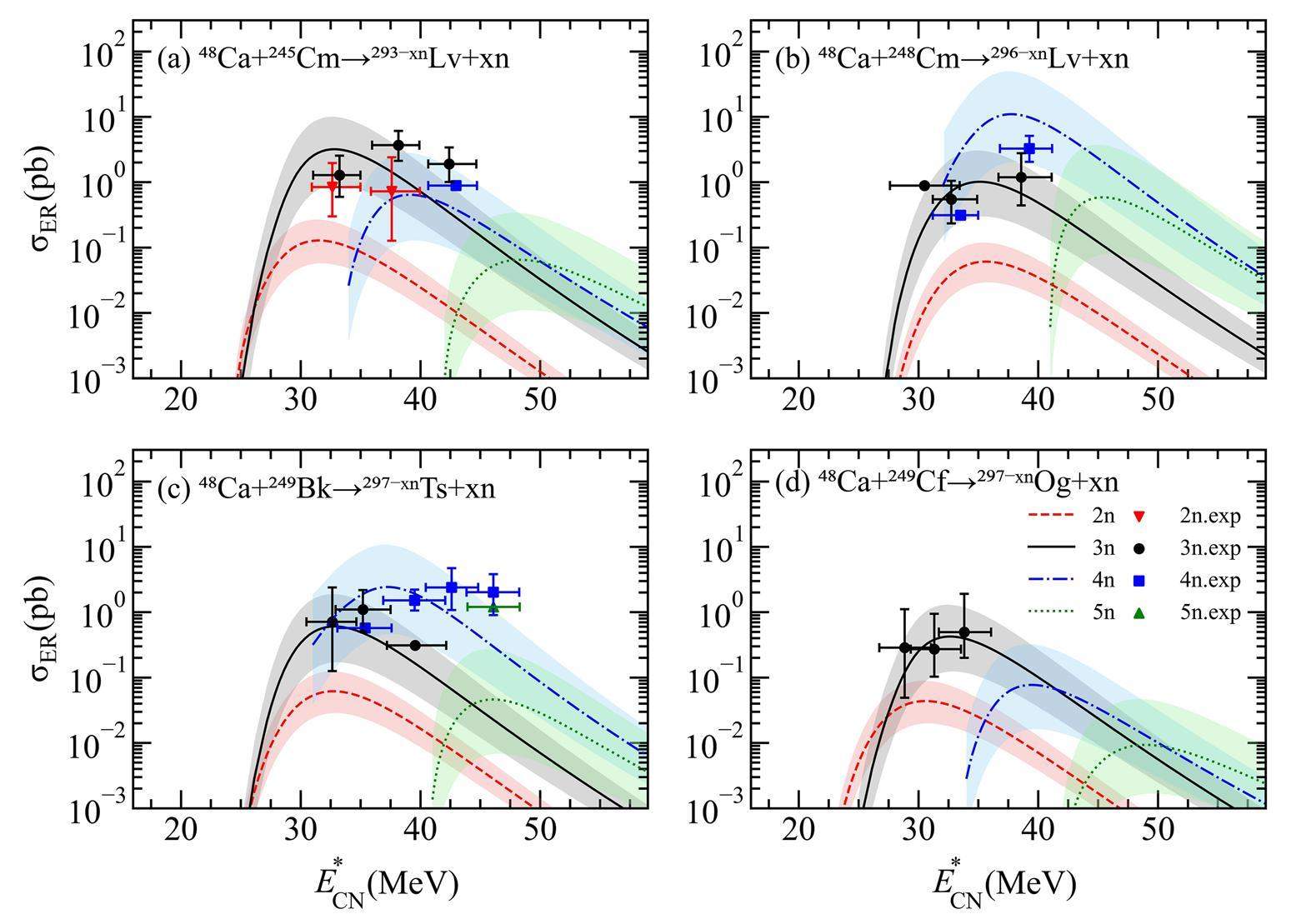
As shown in Figs. 1(a)-(d), the ERCSs show a decreasing trend with increasing proton number of compound nucleus. For the reactions 48Ca + 245Cm and 48Ca + 249Cf, the maximal ERCSs of both the calculation and experiment appeared in the 3n-emission channels. The 4n-emission channels are more favorable for the synthesis of SHN with the reactions 48Ca + 248Cm and 48Ca + 249Bk. The predicted ERCSs aligned well with the experimental results, particularly for the reaction 48Ca + 249Cf. A maximal ERCS of
Results and discussion
To prevent facility contamination by unstable beams, we chose stable projectiles with Z=21–30 and actinide targets with half-lives exceeding 50 d for the experimental duration; the optimal reaction systems are summarized in Table 1. The most favorable reactions and ERCSs (optimal Ec.m.) for producing isotopes 295-302121 are 252Es (46Ti, 3n) 295121, 4.123 fb (223.9 MeV), 248Cf (50V, 3n) 296121, 0.566 fb (239.1 MeV), 254Es (46Ti, 3n) 297121, 6.619 fb (219.9 MeV), 254Es (47Ti, 3n) 298121, 1.331 fb (222.3 MeV), 257Fm (45Sc, 3n) 299121, 8.778 fb (213.6 MeV), 254Es (49Ti, 3n) 300121, 0.453 fb (228.5 MeV), 254Cf (50V, 3n) 301121, 3.705 fb (229.0 MeV), and 254Cf (51V, 3n) 302121, 0.524 fb (234.1 MeV).
| Isotope | Reaction | T1/2(target) | Ec.m.(MeV) | σER(fb) | |
|---|---|---|---|---|---|
| 295121 | 252Es(46Ti,3n) | 1.29 yr | 223.9 | 36.0 | |
| 296121 | 248Cf(50V,3n) | 333.50 d | 239.1 | 36.0 | |
| 297121 | 254Es(46Ti,3n) | 275.70 d | 219.9 | 35.0 | |
| 249Cf(51V,3n) | 351.00 yr | 240.3 | 35.0 | ||
| 298121 | 254Es(47Ti,3n) | 275.70 d | 222.3 | 36.0 | |
| 299121 | 257Fm(45Sc,3n) | 100.50 d | 213.6 | 36.0 | |
| 254Es(48Ti,3n) | 275.70 d | 227.6 | 36.0 | ||
| 252Cf(50V,3n) | 2.64 yr | 232.3 | 34.0 | ||
| 251Cf(51V,3n) | 898.00 yr | 238.2 | 35.0 | ||
| 300121 | 254Es(49Ti,3n) | 275.70 d | 228.5 | 36.0 | |
| 301121 | 254Cf(50V,3n) | 60.50 d | 229.0 | 33.0 | |
| 254Es(50Ti,3n) | 275.70 d | 232.5 | 35.0 | ||
| 302121 | 254Cf(51V,3n) | 60.50 d | 234.1 | 34.0 |
As mentioned in the previous paragraph, the largest maximal ERCS corresponding to the synthesis of the SHE with Z = 121 is 8.778 fb in the reaction 45Sc+257Fm. In addition, the reactions 46Ti+252Es and 46Ti+254Es offer large maximal ERCSs of 4.123 and 6.619 fb, respectively. Considering its experimental feasibility, the 254Es target is currently available among several Es targets in the laboratory [94], with a half-life of 275.70 d. The 252Es target has a comparatively long half-life (1.29 y), making it a potential target for experimental purposes. Therefore, despite the slightly higher ERCS of the reaction 45Sc+257Fm, the reactions 46Ti+252,254Es are more feasible for experimental purposes.
In Figs. 2a-c, we present the calculated ERCSs of the reactions 45Sc+257Fm, 48Ti+254Es, and 51V+251Cf. These reactions yield the same compound nuclei of 302121. Notably, our analysis revealed a consistently decreasing trend in the maximal ERCSs for synthesizing the same isotopes, 299121 via the 3n-emission channel and 298121 via the 4n-emission channel, as the charge number of the projectiles increased. This trend can be attributed to the reduced fusion probability resulting from the increased mass asymmetry. To further investigate the influence of mass asymmetry on the fusion-evaporation reaction, the fusion probabilities and driving potentials for the reactions 45Sc+257Fm, 48Ti+254Es, and 51V+251Cf are presented in Figs. 3 and 4.

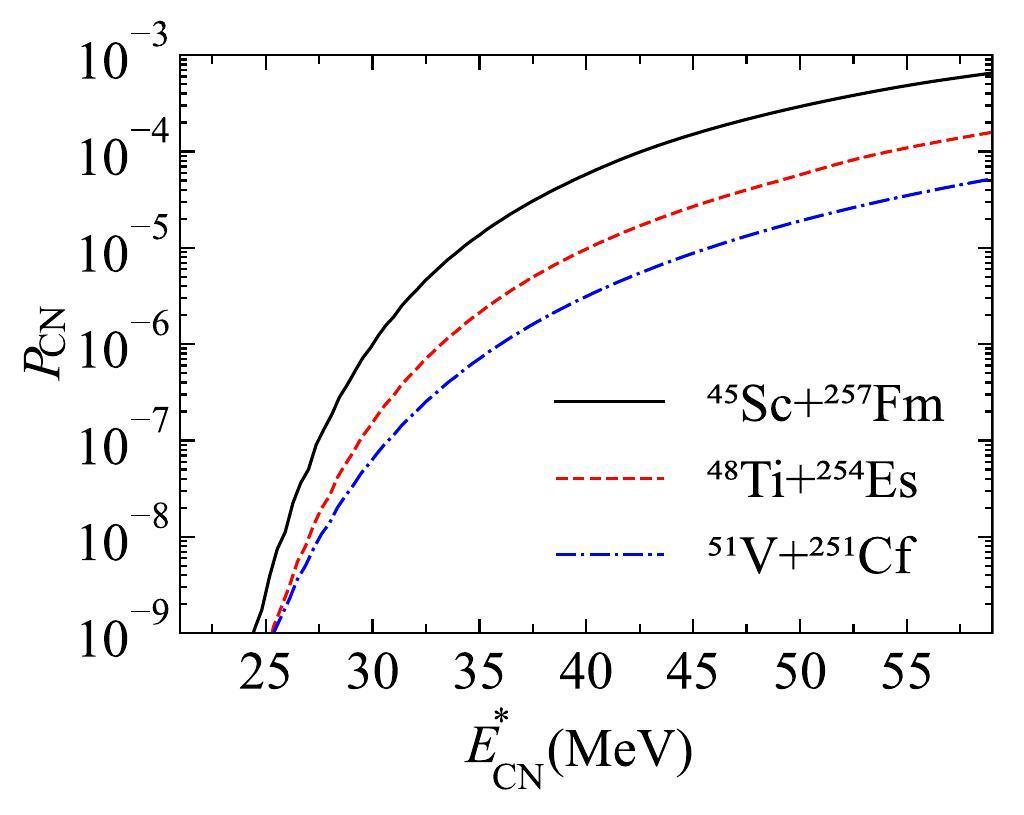
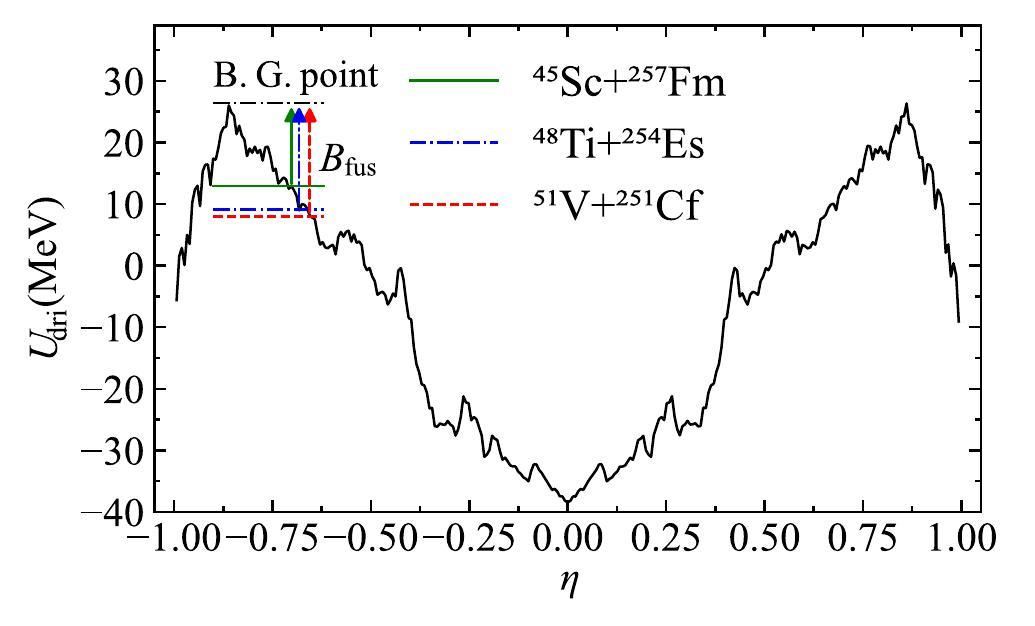
Figure 3 reveals that the fusion probabilities exhibit an increasing trend with increasing
Figure 4 shows that as the mass asymmetry of the reaction system decreases, the entrance channel approaches the B.G. point, resulting in a corresponding decrease in Bfus. For the reaction 45Sc+257Fm, the Bfus is 13.1 MeV, which is lower than the reactions 48Ti+254Es (Bfus=17.1 MeV) and 51V+251Cf (Bfus=17.8 MeV). Consequently, the reaction 45Sc+257Fm is more likely to overcome the inner fusion barrier, resulting in an enhanced fusion probability, as shown in Fig. 3. Evidently, the heightened fusion probabilities, stemming from the reduced mass asymmetry, establish the superiority of Sc- and Ti-induced reactions for producing the SHE with Z = 121.
In Fig. 5, we present an analysis of the calculated maximal ERCSs, corresponding incident energies, and Q values for reactions involving 46-50Ti projectiles and 252,254Es targets. Figure 5(a) reveals that the reactions employing the neutron-rich 254Es target consistently yielded larger maximal ERCSs than those employing the 252Es target. Moreover, the maximum ERCSs decreased as the neutron number of the projectile increased. Notably, odd–even effects also impact the maximal ERCSs, with even-A Ti projectiles resulting in relatively enhanced ERCSs. Figure 5(b) illustrates that the optimal incident energies for reactions with the 252Es target are approximately 3–4 MeV higher than those with the 254Es target. Additionally, the optimal incident energies exhibited a discernible increase, with evident odd–even effects as the neutron number of the projectiles increased.
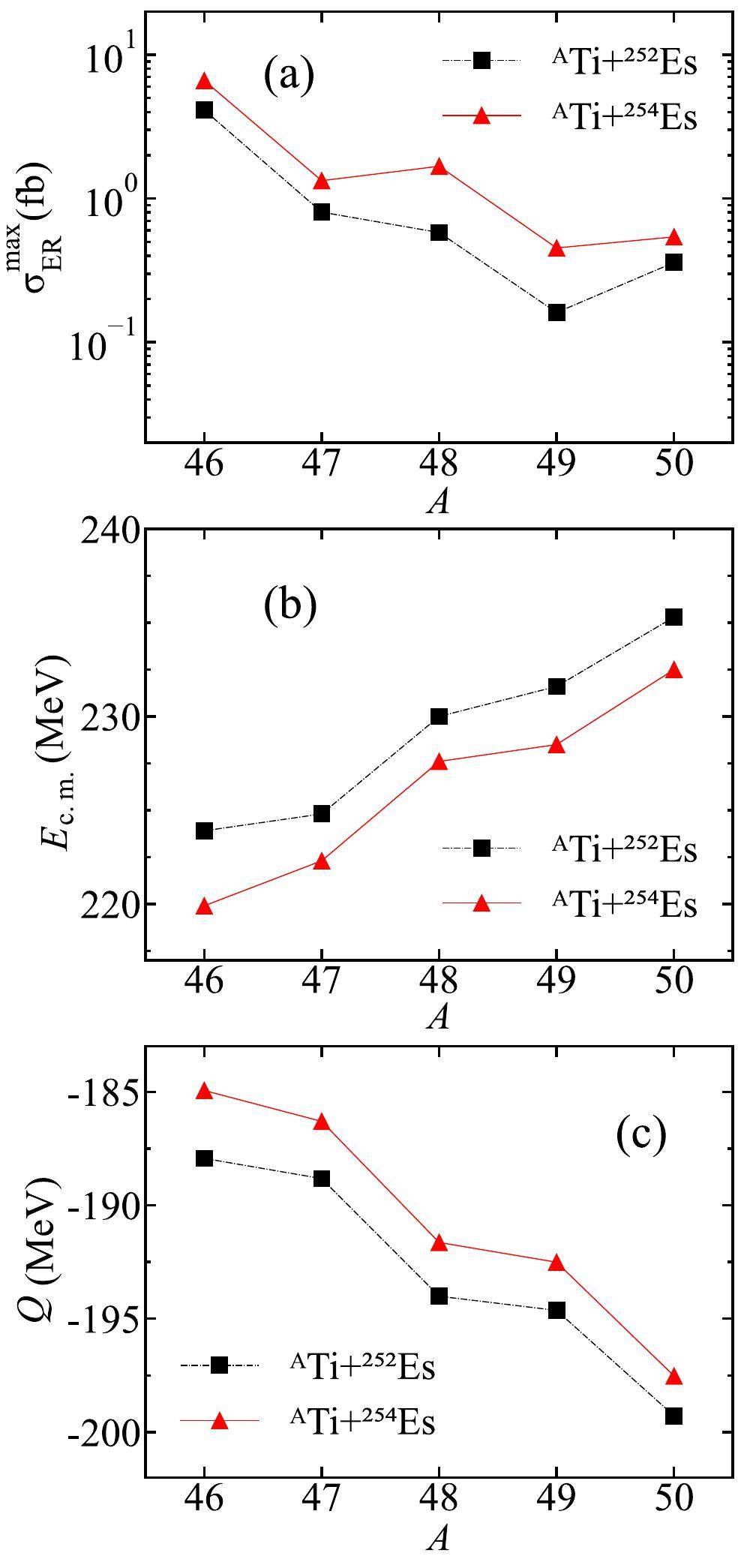
For all reactions 46-50Ti+252Es and 46-50Ti+254Es, the corresponding
A comprehensive investigation of the capture, fusion, and survival stages is essential for determining the isotopic dependence of the maximal ERCSs and the corresponding optimal incident energies. In Fig. 6(a), we present the capture cross sections for the combinations involving 46-50Ti projectiles colliding with 252Es and 254Es targets at excitation energies of
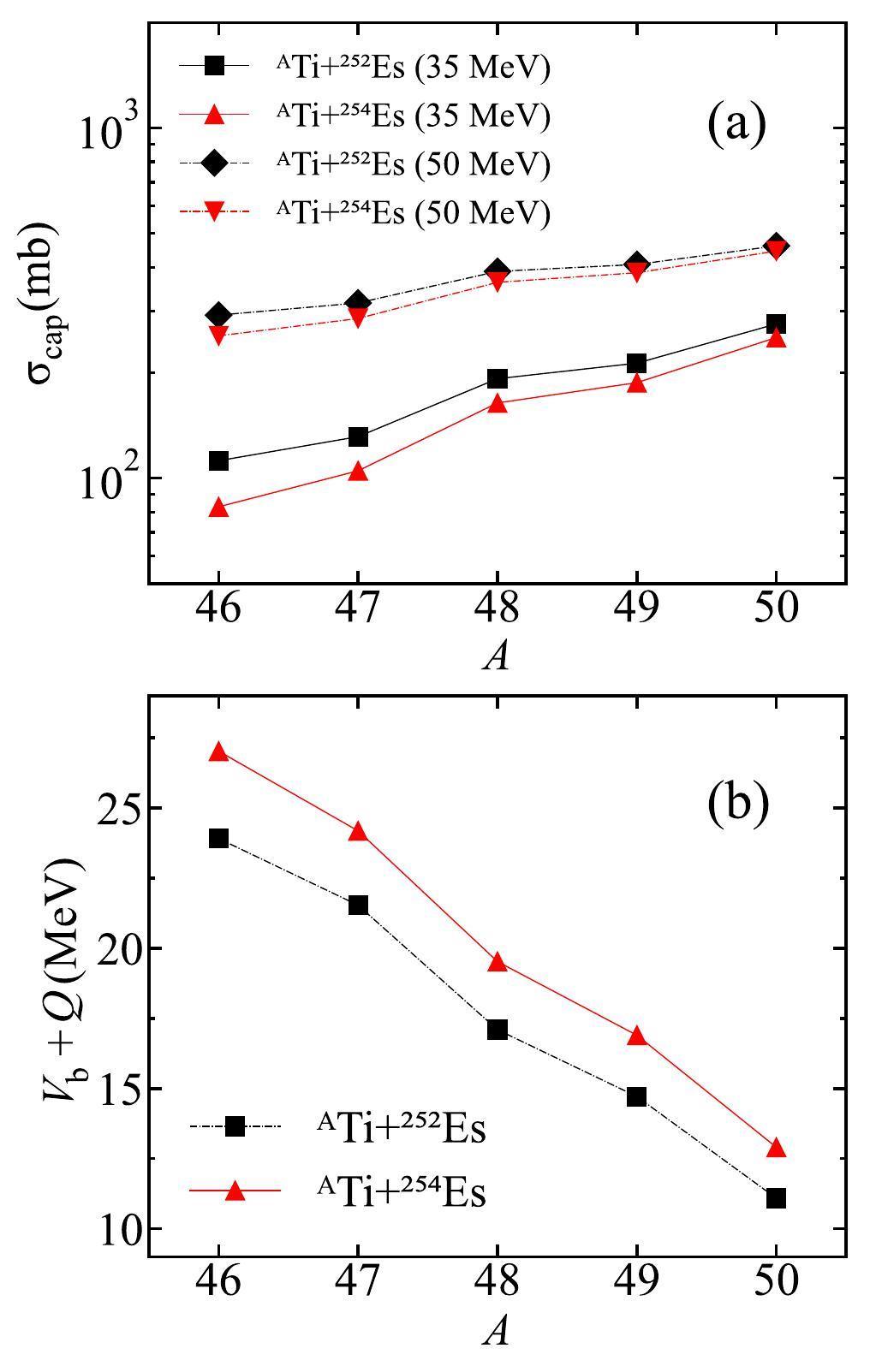
In Fig. 6(b), the excitation energies associated with the Coulomb barriers Vb+Q of the corresponding reactions are plotted. The Vb+Q values decreased with increasing neutron excess in the projectiles. Moreover, the reaction systems with the 252Es target exhibited lower Vb+Q values than those with 254Es targets. Consequently, reactions involving 252Es as target nuclei coupled with neutron-rich Ti projectiles have an increased likelihood of overcoming the Coulomb barrier, thereby enhancing the corresponding capture cross sections.
The fusion process in Fig. 7(a) shows the fusion probabilities of reactions 46-50Ti+252Es and 46-50Ti+254Es at
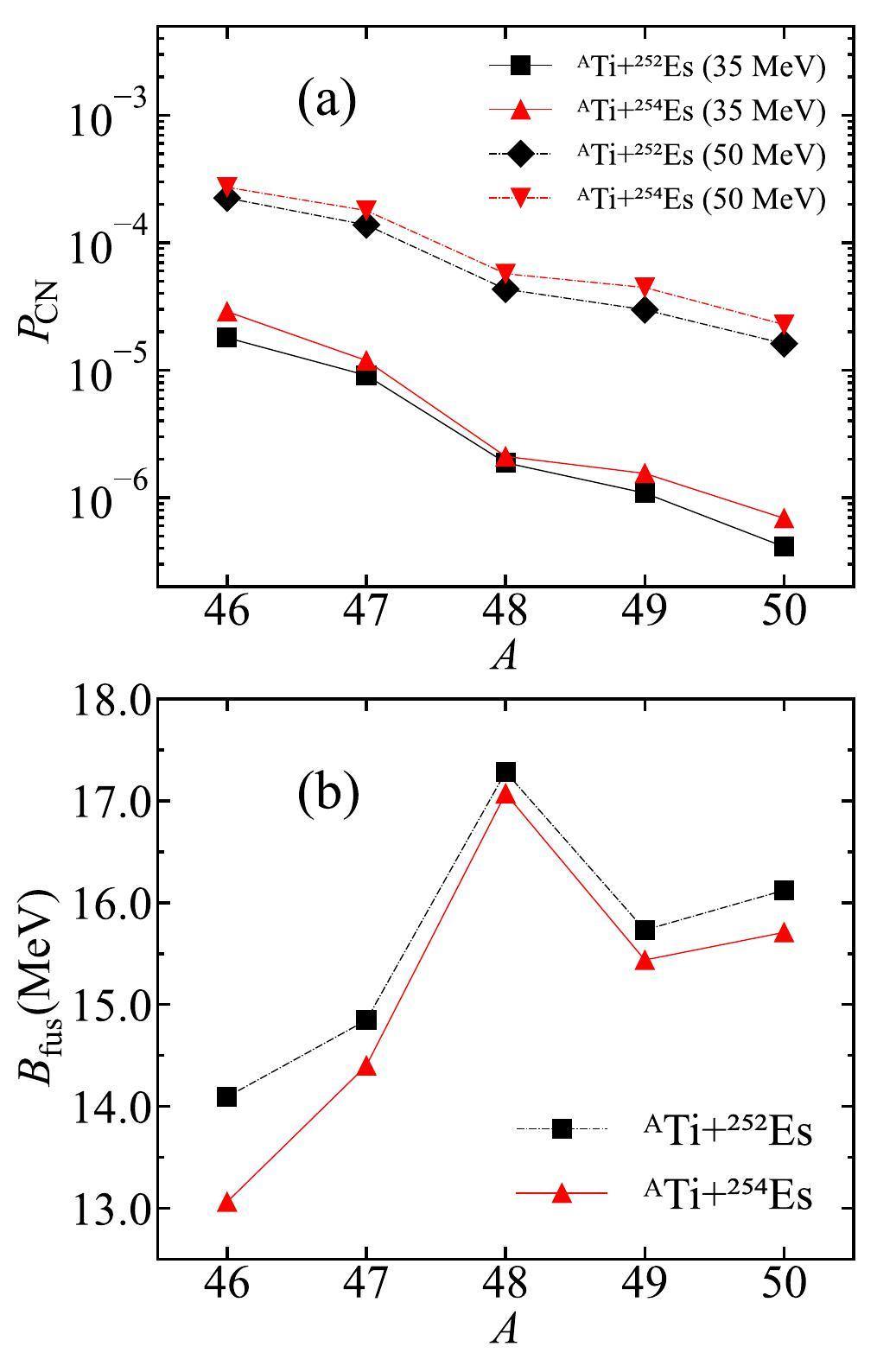
In Fig. 8(a), the survival probabilities of the compound nuclei in the 3n-emission channel for reactions 46-50Ti+252Es and 46-50Ti+254Es at
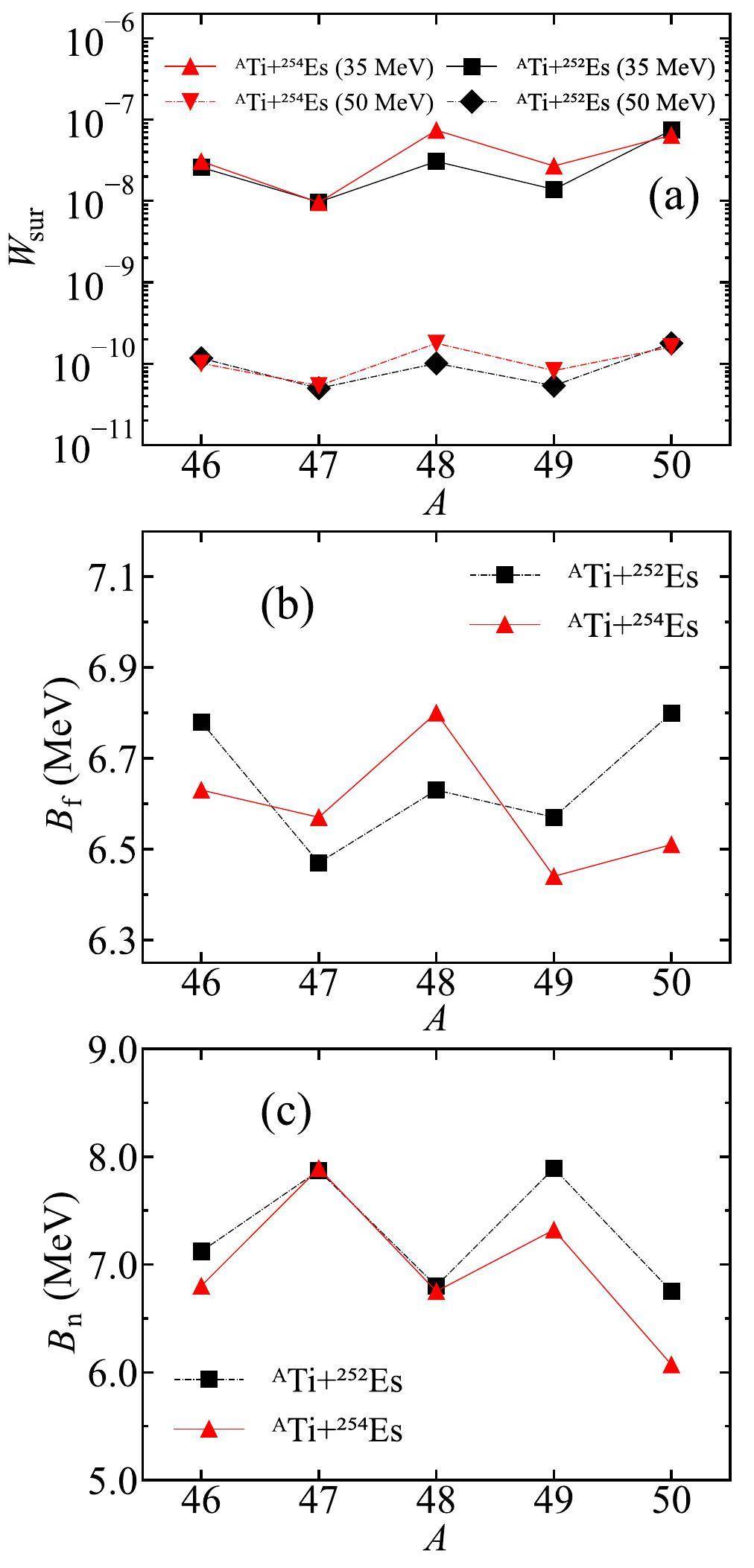
Summary
The calculated ERCSs using the DNS model were assessed using the experimental results of the reactions 48Ca + 245Cm, 48Ca + 248Cm, 48Ca + 249Bk, and 48Ca + 249Cf. Our analysis indicates consistency between the theoretical predictions and the experimental results. Based on the DNS model, we investigated the synthesis of the SHE Z = 121 using stable projectiles with Z=21-30 and actinide targets with half-lives longer than 50 d, revealing that this element is expected to be produced via reactions 45Sc+257Fm, 46Ti + 254Es, and 46Ti + 252Es. Considering the experimental feasibility, the reactions 46Ti + 254Es and 46Ti + 252Es are more favorable with maximal ERCSs and optimal incident energies of 6.619 fb at 219.9 MeV and 4.123 fb at 223.9 MeV.
We investigated the mass asymmetry effect, revealing enhanced fusion probabilities for Sc- and Ti-induced reactions. Additionally, the influences of the Q values, Coulomb barriers, inner fusion barriers, fission barriers, and neutron separation energies on the isotopic dependence of the reactions with Ti projectiles and Es targets were analyzed in detail. Our results indicate that employing a 254Es target and even-A Ti projectiles with a smaller neutron excess is favorable for synthesizing the element Z = 121.
Closed shells for Z > 82 and N > 126 in a diffuse potential well
. Phys. Lett 22. 500-502 (1966). https://doi.org/10.1016/0031-9163(66)91243-1Stability of heavy and superheavy elements
. J. Phys. G Nucl. Part. Phys 20, 1681-1747 (1994). https://doi.org/10.1088/0954-3899/20/11/003Shape coexistence and triaxiality in the superheavy nuclei
. Nature 433, 705-709 (2005). https://doi.org/10.1038/nature03336The discovery of the heaviest elements
. Rev. Mod. Phys. 72, 733-767 (2000). https://doi.org/10.1103/RevModPhys.72.733Experiment on the synthesis of element 113 in the reaction 209Bi (70Zn, n) 278113
. J. Phys. Soc. Jpn 73, 2593-2596 (2004). https://doi.org/10.1143/jpsj.73.2593Attempt to produce element 120 in the 244Pu+ 58Fe reaction
. Phys. Rev. C 79, 024603 (2009). https://doi.org/10.1103/PhysRevC.79.024603Super-heavy element research
. Rep. Prog. Phys 78, 036301 (2015). https://doi.org/10.1088/0034-4885/78/3/036301Synthesis of nuclei of the superheavy element 114 in reactions induced by 48Ca
. Nature 400, 242-245 (1999). https://doi.org/10.1038/22281Investigation of the 243Am+ 48 Ca reaction products previously observed in the experiments on elements 113, 115, and 117
. Phys. Rev. C 87, 014302 (2013). https://doi.org/10.1103/PhysRevC.87.014302Observation of the decay of 292116
. Phys. Rev. C 63, 011301(R) (2000). https://doi.org/10.1103/PhysRevC.63.011301Synthesis of a new element with atomic number Z = 117
. Phys. Rev. Lett 104, 142502 (2010). https://doi.org/10.1103/PhysRevLett.104.142502Synthesis of the isotopes of elements 118 and 116 in the 249Cf and 245Cm+ 48Ca fusion reactions
. Phys. Rev. C 74, 044602 (2006). https://doi.org/10.1103/PhysRevC.74.044602Synthesis of superheavy elements by cold fusion
. Radiochim. Acta 99, 405-428 (2011). https://doi.org/10.1524/ract.2011.1854Regularities of formation and survival probability of compound nuclei in the region of Z ≥ 82: study of complete-fusion reactions with heavy ions using the kinematic separator VASSILISSA
. Phys. Part. Nucl 38, 492-524 (2007). https://doi.org/10.1134/S1063779607040041Observation of the Superheavy Nuclide 271Ds
. Chin. Phys. Lett 29, 012502 (2012). https://doi.org/10.1088/0256-307X/29/1/012502New isotope 286Mc produced in the 243Am+48Ca reaction
. Phys. Rev. C 106, 064306 (2022). https://doi.org/10.1103/PhysRevC.106.064306Review of even element super-heavy nuclei and search for element 120
. Eur. Phys. J. A 52, 180-213 (2016). https://doi.org/10.1140/epja/i2016-16180-4Some critical remarks on a sequence of events interpreted to possibly originate from a decay chain of an element 120 isotope
. Eur. Phys. J. A 53, 123-131 (2017). https://doi.org/10.1140/epja/i2017-12307-5Search for elements 119 and 120
. Phys. Rev. C 102, 064602 (2020). https://doi.org/10.1103/PhysRevC.102.064602Probing optimal reaction energy for synthesis of element 119 from 51V+248Cm reaction with quasielastic barrier distribution measurement
. J. Phys. Soc. Jpn 91, 084201 (2022). https://doi.org/10.7566/JPSJ.91.084201Production cross sections of 243-248No isotopes in fusion reactions
. Phys. Rev. C 106, 014625 (2022). https://doi.org/10.1103/PhysRevC.106.014625Time-dependent Hartree-Fock plus Langevin approach for hot fusion reactions to synthesize the Z=120 superheavy element
. Phys. Rev. C 99, 051602(R) (2019). https://doi.org/10.1103/PhysRevC.99.051602Impact of tensor force on quantum shell effects in quasifission reactions
. Phys. Lett. B 833, 137349 (2022). https://doi.org/10.1016/j.physletb.2022.137349Microscopic study of fusion reactions with a weakly bound nucleus: Effects of deformed halo
. Phys. Rev. C 107, L011601 (2023). https://doi.org/10.1103/PhysRevC.107.L011601Microscopic study of the hot-fusion reaction 48Ca+238U with the constraints from time-dependent Hartree-Fock theory
. Phys. Rev. C 107, 064609 (2023). https://doi.org/10.1103/PhysRevC.107.064609The Fusion-by-Diffusion model as a tool to calculate cross sections for the production of superheavy nuclei
. Eur. Phys. J. A 58, 231-248 (2022). https://doi.org/10.1140/epja/s10050-022-00891-8Possibility to form Z=120 via the 64Ni+238U reaction using the dynamical cluster-decay model
. Phys. Rev. C 105, 014610 (2022). https://doi.org/10.1103/PhysRevC.105.014610Elimination of fast variables and initial slip: a new mechanism for fusion hindrance in heavy-ion collisions
. J. Phys. G: Nucl. Part. Phys 46, 115102 (2019). https://doi.org/10.1088/1361-6471/ab11efResidue cross sections of 50Ti-induced fusion reactions based on the two-step model
. Eur. Phys. J. A 52, 35-39 (2016). https://doi.org/10.1140/epja/i2016-16035-0Fusion cross sections for superheavy nuclei in the dinuclear system concept
. Nucl. Phys. A 633, 409-420 (1998). https://doi.org/10.1016/S0375-9474(98)00124-9Production of neutron-rich isotopes 264, 266, 268, 269Rf by multinucleon transfer reactions based on 238U beam
. Phys. Rev. C 100, 024613 (2019). https://doi.org/10.1103/PhysRevC.100.024613Influence of the neutron numbers of projectile and target on the evaporation residue cross sections in hot fusion reactions
. Phys. Rev. C 93, 064610 (2016). https://doi.org/10.1103/PhysRevC.93.064610Predictions for the synthesis of superheavy elements Z = 119 and 120
. Phys. Rev. C 98, 014618 (2018). https://doi.org/10.1103/PhysRevC.98.014618Multinucleon transfer reaction from view point of dynamical dinuclear system method
. J. Phys. G Nucl. Part. Phys 47, 075106 (2020). https://doi.org/10.1088/1361-6471/ab8dccTheoretical study of the synthesis of superheavy nuclei with Z=119 and 120 in heavy-ion reactions with trans-uranium targets
. Phys. Rev. C 85, 041601(R) (2012). https://doi.org/10.1103/PhysRevC.85.041601Influence of entrance channel on production cross sections of superheavy nuclei
. Phys. Rev. C 96, 024610 (2017). https://doi.org/10.1103/PhysRevC.85.041601Predictions for production of superheavy nuclei with z = 105-112 in hot fusion reactions
. Nucl. Sci. Tech 29, 154 (2018). https://doi.org/10.1007/s41365-018-0501-2Prediction of synthesis cross sections of new moscovium isotopes in fusion-evaporation reactions
. Nucl. Sci. Tech 34, 7 (2023). https://doi.org/10.1007/s41365-022-01157-0Production of heavy neutron-rich nuclei with radioactive beams in multinucleon transfer reactions
. Nucl. Sci. Tech 28, 110 (2017). https://doi.org/10.1007/s41365-017-0266-zYield of long-lived fission product transmutation using proton-, deuteron-, and alpha particle-induced spallation
. Nucl. Sci. Tech 32, 96 (2021). https://doi.org/10.1007/s41365-021-00933-8Predictions of synthesizing elements with Z=119 and 120 in fusion reactions
. Phys. Rev. C 109 014622 (2024). https://doi.org/10.1103/PhysRevC.109.014622.Production of neutron-rich actinide isotopes in isobaric collisions via multinucleon transfer reactions
. Nucl. Sci. Tech 34 160 (2023). https://doi.org/10.1007/s41365-023-01314-z.Cluster emission in massive transfer reactions based on dinuclear system model
. Nucl. Tech 46, 030501 (2023). https://doi.org/10.11889/j.0253-3219.2023.hjs.46.030501 (in Chinese)Progress in transport models of heavy-ion collisions for the synthesis of superheavy nuclei
. Nucl. Tech 46, 137 (2023). https://doi.org/10.11889/j.0253-3219.2023.hjs.46.080014 (in Chinese)Production cross sections of superheavy elements Z = 119 and 120 in hot fusion reactions
. Phys. Rev. C 89, 024615 (2014). https://doi.org/10.1103/PhysRevC.89.024615Theoretical study of evaporation-residue cross sections of superheavy nuclei
. Phys. Rev. C 103, 064616 (2021). https://doi.org/10.1103/PhysRevC.103.064616Systematics of fusion probability in “hot”fusion reactions
. Phys. Rev. C 84, 061601(R) (2011). https://doi.org/10.1103/PhysRevC.84.061601Applications of skyrme energy-density functional to fusion reactions for synthesis of superheavy nuclei
. Phys. Rev. C 74, 044604 (2006). https://doi.org/10.1103/PhysRevC.74.044604Possibilities for synthesis of new neutron-deficient isotopes of superheavy nuclei*
. Chin. Phys. C 43, 054105 (2019). https://doi.org/10.1088/1674-1137/43/5/054105Predictions for the synthesis of the Z=120 superheavy element
. Phys. Rev. C 106, 034613 (2022). https://doi.org/10.1103/PhysRevC.106.034613Examination of promising reactions with 241Am and 244Cm targets for the synthesis of new superheavy elements within the dinuclear system model with a dynamical potential energy surface
. Phys. Rev. C 107, 014616 (2023). https://doi.org/10.1103/PhysRevC.107.014616Analysis of the fusion mechanism in the synthesis of superheavy element 119 via the 54Cr+243Am reaction
. Phys. Rev. C 105, 014618 (2022). https://doi.org/10.1103/PhysRevC.105.014618Hot and cold fusion reactions leading to the same superheavy evaporation residue
. Eur. Phys. J. A 58, 180-183 (2022). https://doi.org/10.1140/epja/s10050-022-00826-3Non-frozen process of heavy-ion fusion reactions at deep sub-barrier energies
. Nucl. Sci. Tech. 33, 132 (2022). https://doi.org/10.1007/s41365-022-01114-xProduction of p-rich nuclei with z= 20-25 based on radioactive ion beams
. Nucl. Sci. Tech. 33, 55 (2022). https://doi.org/10.1007/s41365-022-01048-4Bayesian analysis on non-resonant behavior of 12C + 12C fusion reaction at sub-barrier energies
. Chin. Phys. C 46, 064105 (2022). https://doi.org/10.1088/1674-1137/ac5587Possibility to synthesize Z=120 superheavy nuclei with Z > 20 projectiles
. Phys. Rev. C 108, 014604 (2023). https://doi.org/10.1103/PhysRevC.108.014604Random forest-based prediction of decay modes and half-lives of superheavy nuclei
. Nucl. Sci. Tech. 34 204 (2023). https://doi.org/10.1007/s41365-023-01354-5Predictions of the decay properties of the superheavy nuclei 293, 294119 and 294, 295120
. Nucl. Tech 46 114 (2023). https://doi.org/10.11889/j.0253-3219.2023.hjs.46.080011 (in Chinese)Synthesis of superheavy nuclei: Nucleon collectivization as a mechanism for compound nucleus formation
. Phys. Rev. C 64, 034606 (2001). https://doi.org/10.1103/PhysRevC.64.034606Survival probability of superheavy nuclei
. Phys. Rev. C 65, 024308 (2002). https://doi.org/10.1103/PhysRevC.65.024308Production cross sections of superheavy nuclei based on dinuclear system model
. Nucl. Phys. A 771, 50-67 (2006). https://doi.org/10.1016/j.nuclphysa.2006.03.002Nuclear masses and deformations
. Nucl. Phys. 81, 1-60 (1966). https://doi.org/10.1016/0029-5582(66)90639-0Interaction barrier in charged-particle nuclear reactions
. Phys. Rev. Lett. 31, 766-769 (1973). https://doi.org/10.1103/PhysRevLett.31.766Tunnelling through the morse barrier
. Phys. Lett. A 157, 1-5 (1991). https://doi.org/10.1016/0375-9601(91)90399-SExpression for the heavy-ion fusion cross section
. Phys. Rev. C 107, 054618 (2023). https://doi.org/10.1103/PhysRevC.107.054618Fusion dynamics of astrophysical reactions using different transmission coefficients
. Eur. Phys. J. A 58, 241 (2022). https://doi.org/10.1140/epja/s10050-022-00893-6Systematics of capture and fusion dynamics in heavy-ion collisions
. At. Data Nucl. Data Tables 114, 281-370 (2017). https://doi.org/10.1016/j.adt.2016.06.003Nuclear ground-state masses and deformations: FRDM(2012)
. At. Data. Nucl. Data Tables. 109-110, 1-204 (2016). https://doi.org/10.1016/j.adt.2015.10.002Nuclear hexadecapole deformation effects on the production of super-heavy elements
. Chin. Phys. Lett. 27, 062502 (2010). https://doi.org/10.1088/0256-307X/27/6/062502Distribution of the dissipated angular momentum in heavy-ion collisions
. Phys. Rev. C 27, 590-601 (1983). https://doi.org/10.1103/PhysRevC.27.590Microscopic transport theory of heavy-ion collisions
. Z. Phys. A 277, 299-310 (1976). https://doi.org/10.1007/BF01415605Characteristics of quasifission products within the dinuclear system model
. Phys. Rev. C 68, 034601 (2003). https://doi.org/10.1103/PhysRevC.68.034601Influence of the nuclear dynamical deformation on production cross sections of superheavy nuclei
. Phys. Rev. C 91, 011603 (2015). https://doi.org/10.1103/PhysRevC.91.011603A schematic model for (p, xn) cross sections in heavy elements
. Can. J. Phys. 34, 767-779 (1956). https://doi.org/10.1139/p56-087Statistics and nuclear reactions
. Phys. Rev. 52, 295-303 (1937). https://doi.org/10.1103/PhysRev.52.295Role of the collective effects in a systematics of nuclear level density
. Sov. J. Nucl. Phys. 29, 875 (1979).Decay of deformed and superdeformed nuclei formed in heavy ion reactions
. Phys. Rev. C 21, 1770-1782 (1980). https://doi.org/10.1103/PhysRevC.21.1770The mechanism of nuclear fission
. Phys. Rev. 56, 426-450 (1939). https://doi.org/10.1103/PhysRev.56.426Analysis of survival probability of superheavy nuclei
. Phys. Rev. C 62, 064303 (2000). https://doi.org/10.1103/PhysRevC.62.064303Survival probabilities of superheavy nuclei based on recent predictions of nuclear properties
. Eur. Phys. J. A 23, 249 (2005). https://doi.org/10.1140/epja/i2004-10089-5Selection of projectiles for producing trans-uranium nuclei in transfer reactions within the improved dinuclear system model
. J. Phys. G Nucl. Part. Phys 47, 065107 (2020). https://doi.org/10.1088/1361-6471/ab871fCalculation of the fission width of an excited nucleus with the fission barrier dependent on excitation energy
. Phys. Rev. C 98, 024601 (2018). https://doi.org/10.1103/PhysRevC.98.024601Odd–even effects of the survival probability for superheavy compound nuclei
. Chin. Phys. Lett. 21, 636 (2004). https://doi.org/10.1088/0256-307X/21/4/013Systematic study of survival probability of excited superheavy nuclei
. Sci. China Phys. Mech. Astron. 54, 109-113 (2011). https://doi.org/10.1007/s11433-011-4438-2Measurements of cross sections for the fusion-evaporation reactions 244Pu (48Ca, xn) 292- x114 and 245Cm (48Ca, xn) 293- x116
. Phys. Rev. C 69, 054607 (2004). https://doi.org/10.1103/PhysRevC.69.054607Measurements of cross sections and decay properties of the isotopes of elements 112, 114, and 116 produced in the fusion reactions 233, 238U, 242Pu, and 248Cm+48Ca
. Phys. Rev. C 70, 064609 (2004). https://doi.org/10.1103/PhysRevC.70.064609Studies of the 249Bk+ 48Ca reaction including decay properties and excitation function for isotopes of element 117 and discovery of the new isotope 277Mt
. Phys. Rev. C 87, 054621 (2013). https://doi.org/10.1103/PhysRevC.87.054621Production and decay of the heaviest nuclei 293,294117 and 294118
. Phys. Rev. Lett 109, 162501 (2012). https://doi.org/10.1103/PhysRevLett.109.162501Study of the 249-251Cf+ 48Ca reactions: recent results and outlook
. J. Phys Conf. Ser 966, 012057 (2018). https://doi.org/10.1088/1742-6596/966/1/012057Synthesis of superheavy elements: Uncertainty analysis to improve the predictive power of reaction models
. Phys. Rev. C 94, 034616 (2016). https://doi.org/10.1103/PhysRevC.94.034616Systematic study of fission barriers of excited superheavy nuclei
. Phys. Rev. C 80, 011302(R) (2009). https://doi.org/10.1103/PhysRevC.80.011302The NUBASE2020 evaluation of nuclear physics properties
. Chin. Phys. C 45, 030001 (2021). https://doi.org/10.1088/1674-1137/abddaeSearch for superheavy elements using the 48Ca+254Esg reaction
. Phys. Rev. C 32, 1760-1763 (1985). https://doi.org/10.1103/PhysRevC.32.1760Feng-Shou Zhang is an editorial board member for Nuclear Science and Techniques and was not involved in the editorial review, or the decision to publish this article. All authors declare that there are no competing interests.


